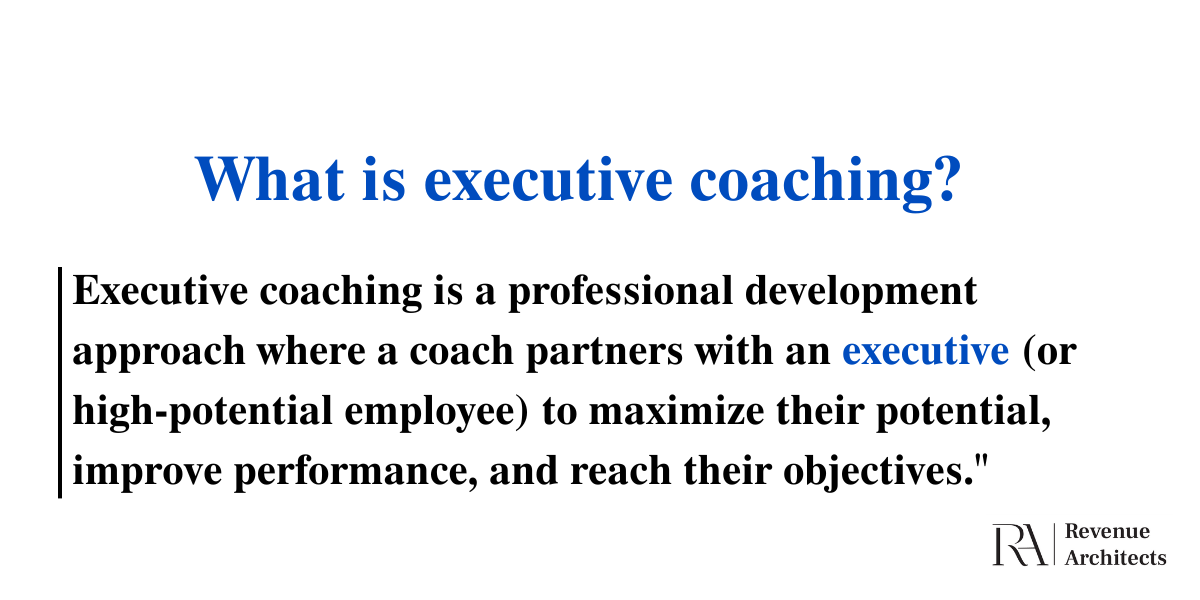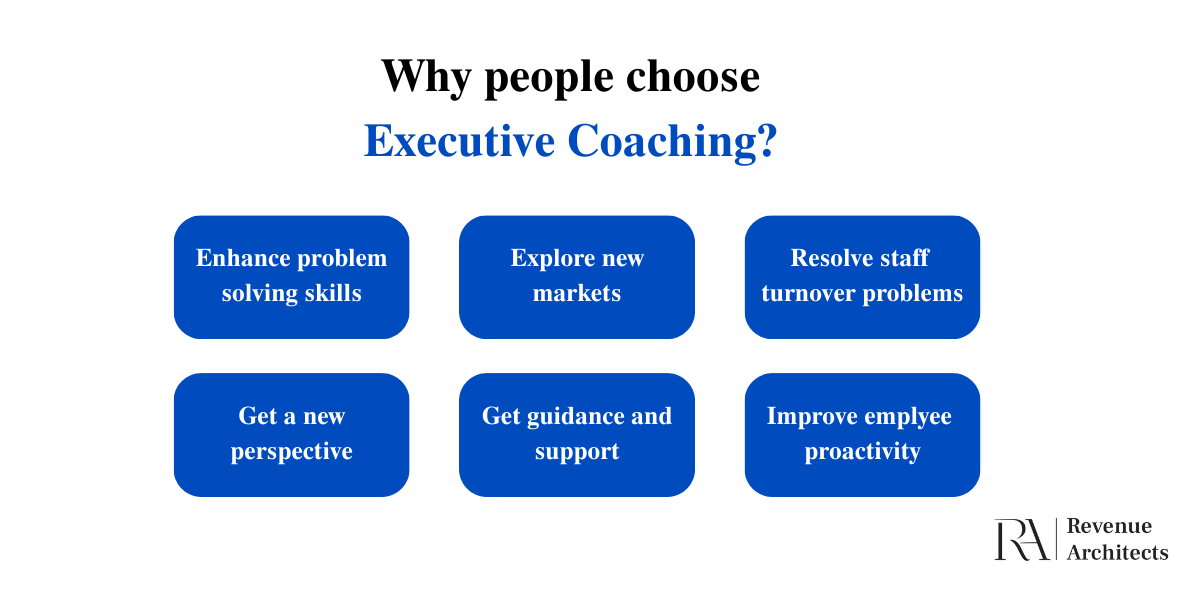In pursuing business and team development, leaders often forget that change starts with themselves. This is a mistake! A leader’s transformation can gently and effectively enhance team productivity, creating a cohesive and robust organism capable of achieving ambitious goals.
Our excerpts here at Revenue Architects discuss the nature of executive coaching, where leaders can draw strength and energy for transformation, and the importance of leaders infusing their values and meanings into their roles.
Executive coaching or coaching for executives empowers leaders through a dialogue where the coach asks questions that guide the client to transform their understanding of their situation and context. This process broadens the leader’s perspective, enabling them to see the bigger picture and gain additional motivation and energy to apply new tools and methods learned during coaching. The result is a transformation in behaviour and increased leadership effectiveness, giving leaders a sense of control and capability.

Executive coaching can be initiated by the leader or higher management. In the latter case, the first meeting takes place in a three-way format (client—higher management, client—leader, and coach). This collaborative approach ensures that the client’s request is understood and the task is discussed with all parties involved. After a series of coaching sessions, the client is invited to assess the results achieved and the transformations that have occurred, fostering a sense of support and understanding.
Leaders often turn to coaches at a crossroads, facing decisions that can significantly impact their business. Coaching reveals a range of options and possibilities, opening up choices through session questions such as:
Typically, executive coaching addresses requests to improve managerial effectiveness or develop specific skills and competencies. For example, these might include:
Enhancing managerial effectiveness involves improving the quality of interactions with the team and addressing the following issues:
It is crucial to note that executive coaching focuses on the leader and their skills, not the team. The coach does not directly influence how the team operates or its principles. Instead, the coach creates a session environment that allows clients to increase their awareness of the processes they manage and are involved in. This heightened awareness enables leaders to see the unfolding narrative more clearly and act accordingly. Working on the leader’s beliefs, perspectives, and reactions changes their behaviour and motivates them to change. This internal transformation of the leader then positively impacts their subordinates, fostering a sense of hope and optimism.
Motivation for work comes from the client’s desire to learn new skills to adapt to changing situations and from feedback from higher management or subordinates highlighting areas of improvement.

There needs to be more clarity between executive coaching and business coaching, and coaches are sometimes mistaken for trainers. Understanding the terminology is essential to choosing the right expert for the problem.
Business and executive coaching involves the client: a top manager, department head, or employee influencing critical business indicators. The difference lies in the object of change. Executive coaching focuses on the client’s competencies and personal traits, while business coaching targets the transformation of internal company processes, such as finance, logistics, or marketing. The type of coaching chosen depends on the client’s goals, with specific tools determined during the sessions.
A trainer imparts knowledge about new methods and working methods, creating an environment where clients practice new tools.
A coach, on the other hand, does not teach, share knowledge, or give advice. Instead, they focus on the processes the client experiences: their worldview, beliefs, and reactions. The coach’s questions help increase awareness, allowing the client to see the situation differently and find new ways to respond.
Coaches do not provide ready-made answers but create a space where clients discover answers within themselves. My clients, usually in leadership positions, often have extensive backgrounds, have completed numerous training courses, read management books, and developed various skills and tools. This, combined with their inner potential, provides a foundation for finding answers to seemingly unsolvable questions, which I help highlight and emphasise.
Executive coaching helps leaders act differently, leading to qualitatively different team results. This transformation occurs through personal qualities, the development of abilities and competencies, and the realisation of the values that leaders bring to work processes and interactions with employees. Changes also involve the leader’s identity, addressing the question: “What kind of leader do I need to become for the team to achieve its goals?”
During sessions, the coach is a researcher, meticulously studying the client. What the client says is essential, but even more significant are the beliefs expressed through non-verbal cues—emotions and movements provide valuable information.
When necessary, the coach reflects their observations to the client, asking questions that help them understand the situation’s essence and previously intangible aspects. This expands the field of potential solutions and opportunities.
Executive coaching helps leaders find energy sources needed to move or accelerate processes. This resource is concentrated on the past, present, and future. During sessions, we often refer to the client’s successful experiences, which have proven effective in the past but have since been forgotten. The leader draws strength from the past, enriching the current situation.

Image by Tung Lam from Pixabay
We also harness the positive energy of the present. Even in the most challenging situations, there is usually some positivity that the leader might overlook. I help identify and use these growth areas as power drivers.
Working with the future involves “unpacking” the energy and resources accumulated by visualizing and visualizing desired changes.
Thus, considering their renewed and expanded vision, the client adapts past experiences to the current situation.
This process may seem simple, but leaders often need more time or focus on properly addressing and prioritising such tasks. This is where executive coaching comes in. It shows that answers can be found today with no losses, and the coach becomes a partner in responding to today’s challenges effectively and appropriately.
We live in an era of rapid change, which brings significant challenges and great opportunities. Leaders must develop team management skills, flexibility, and self-confidence to remain viable. While these have always been crucial leadership qualities, their content has changed. Here’s how:
People often seek coaching for executives to strengthen their teams and find support and resources within their staff. This highlights the need for partnership relationships to seek the best solutions and quickly achieve goals. In such cases, we recommend clients revisit previously established principles of working with their team, if applicable. Sometimes, the criteria for selecting employees and building relationships with them need reassessment. Leaders may need a team with different skills, values, and principles. Such realizations don’t necessarily lead to mass layoffs; this valuable information helps employees identify their development vectors, allowing them to shine and align with circumstances.
Another approach is to focus on the strengths of the team and individual members and past successful projects. Here, we draw on the leader’s internal strength, which becomes the anchor point.
Executive coaching is a transformative journey for leaders aiming to excel in today’s dynamic business landscape. This article explored how coaching empowers executives to enhance their performance, develop self-awareness, and navigate complexities with clarity. Embracing guided dialogue and strategic insight enables leaders to unlock their potential and cultivate a culture of growth within their teams and organizations.
At Revenue Architects, we specialize in providing tailored executive coaching courses and services designed to meet the unique needs of leaders like you. Our approach combines online consultations with a hands-on methodology, ensuring that you receive personalized guidance every step of the way. With a proven track record of working with renowned tech companies worldwide, we bring unparalleled expertise to the table.
Book an appointment today via the contact form on our website and embark on a journey of self-discovery, growth, and achievement.
Growthnetix OÜ
Harju maakond Kesklinna
linnaosa, Ahtri tn 12, 10151
Tallinn, Estonia
VAT number: EE102550717